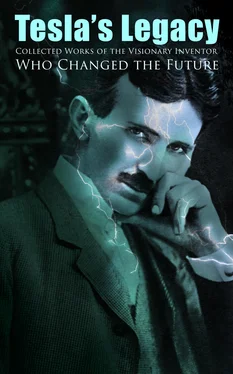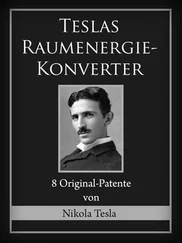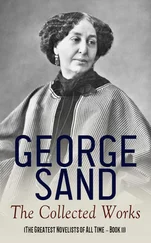One day, as I was roaming in the mountains, I sought shelter from an approaching storm. The sky became overhung with heavy clouds but somehow the rain was delayed until, all of a sudden, there was a lightning flash and a few moments after a deluge. This observation set me thinking. It was manifest that the two phenomena were closely related, as cause and effect, and a little reflection led me to the conclusion that the electrical energy involved in the precipitation of the water was inconsiderable, the function of lightning being much like that of a sensitive trigger.
Here was a stupendous possibility of achievement. If we could produce electric effects of the required quality, this whole planet and the conditions of existence on it could be transformed. The sun raises the water of the oceans and winds drive it to distant regions where it remains in a state of most delicate balance. If it were in our power to upset it when and wherever desired, this mighty life-sustaining stream could be at will controlled. We could irrigate arid deserts, create lakes and rivers and provide motive power in unlimited amounts. This would be the most efficient way of harnessing the sun to the uses of man. The consummation depended on our ability to develop electric forces of the order of those in nature. It seemed a hopeless undertaking, but I made up my mind to try it and immediately on my return to the United States, in the Summer of 1892, work was begun which was to me all the more attractive, because a means of the same kind was necessary for the successful transmission of energy without wires.
The first gratifying result was obtained in the spring of the succeeding year when I reached tensions of about 1,000,000 volts with my conical coil. That was not much in the light of the present art, but it was then considered a feat. Steady progress was made until the destruction of my laboratory by fire in 1895, as may be judged from an article by T. C. Martin which appeared in the April number of the Century Magazine. This calamity set me back in many ways and most of that year had to be devoted to planning and reconstruction. However, as soon as circumstances permitted, I returned to the task.
Although I knew that higher electro-motive forces were attainable with apparatus of larger dimensions, I had an instinctive perception that the object could be accomplished by the proper design of a comparatively small and compact transformer. In carrying on tests with a secondary in the form of a flat spiral, as illustrated in my patents, the absence of streamers surprised me, and it was not long before I discovered that this was due to the position of the turns and their mutual action. Profiting from this observation I resorted to the use of a high tension conductor with turns of considerable diameter sufficiently separated to keep down the distributed capacity, while at the same time preventing undue accumulation of the charge at any point. The application of this principle enabled me to produce pressures of 4,000,000 volts, which was about the limit obtainable in my new laboratory at Houston Street, as the discharges extended through a distance of 16 feet. A photograph of this transmitter was published in the Electrical Review of November, 1898.
In order to advance further along this line I had to go into the open, and in the spring of 1899, having completed preparations for the erection of a wireless plant, I went to Colorado where I remained for more than one year. Here I introduced other improvements and refinements which made it possible to generate currents of any tension that may be desired. Those who are interested will find some information in regard to the experiments I conducted there in my article, "The Problem of Increasing Human Energy" in the Century Magazine of June, 1900, to which I have referred on a previous occasion.
I have been asked by the Electrical Experimenter to be quite explicit on this subject so that my young friends among the readers of the magazine will clearly understand the construction and operation of my "Magnifying Transmitter" and the purposes for which it is intended. Well, then, in the first place, it is a resonant transformer with a secondary in which the parts, charged to a high potential, are of considerable area and arranged in space along ideal enveloping surfaces of very large radii of curvature, and at proper distances from one another thereby insuring a small electric surface density everywhere so that no leak can occur even if the conductor is bare. It is suitable for any frequency, from a few to many thousands of cycles per second, and can be used in the production of currents of tremendous volume and moderate pressure, or of smaller amperage and immense electromotive force. The maximum electric tension is merely dependent on the curvature of the surfaces on which the charged elements are situated and the area of the latter.
Judging from my past experience, as much as 100,000,000 volts are perfectly practicable. On the other hand currents of many thousands of amperes may be obtained in the antenna. A plant of but very moderate dimensions is required for such performances. Theoretically, a terminal of less than 90 feet in diameter is sufficient to develop an electromotive force of that magnitude while for antenna currents of from 2,000-4,000 amperes at the usual frequencies it need not be larger than 30 feet in diameter.
In a more restricted meaning this wireless transmitter is one in which the Hertz-wave radiation is an entirely negligible quantity as compared with the whole energy, under which condition the damping factor is extremely small and an enormous charge is stored in the elevated capacity. Such a circuit may then be excited with impulses of any kind, even of low frequency and it will yield sinusoidal and continuous oscillations like those of an alternator.
Taken in the narrowest significance of the term, however, it is a resonant transformer which, besides possessing these qualities, is accurately proportioned to fit the globe and its electrical constants and properties, by virtue of which design it becomes highly efficient and effective in the wireless transmission of energy. Distance is then absolutely eliminated, there being no diminution in the intensity of the transmitted impulses. It is even possible to make the actions increase with the distance from the plant according to an exact mathematical law.
This invention was one of a number comprised in my "World-System" of wireless transmission which I undertook to commercialize on my return to New York in 1900. As to the immediate purposes of my enterprise, they were clearly outlined in a technical statement of that period from which I quote:
"The 'World-System' has resulted from a combination of several original discoveries made by the inventor in the course of long continued research and experimentation. It makes possible not only the instantaneous and precise wireless transmission of any kind of signals, messages or characters, to all parts of the world, but also the inter-connection of the existing telegraph, telephone, and other signal stations without any change in their present equipment. By its means, for instance, a telephone subscriber here may call up and talk to any other subscriber on the Globe. An inexpensive receiver, not bigger than a watch, will enable him to listen anywhere, on land or sea, to a speech delivered or music played in some other place, however distant. These examples are cited merely to give an idea of the possibilities of this great scientific advance, which annihilates distance and makes that perfect natural conductor, the Earth, available for all the innumerable purposes which human ingenuity has found for a line-wire. One far-reaching result of this is that any device capable of being operated thru one or more wires (at a distance obviously restricted) can likewise be actuated, without artificial conductors and with the same facility and accuracy, at distances to which there are no limits other than those imposed by the physical dimensions of the Globe. Thus, not only will entirely new fields for commercial exploitation be opened up by this ideal method of transmission but the old ones vastly extended.
Читать дальше











